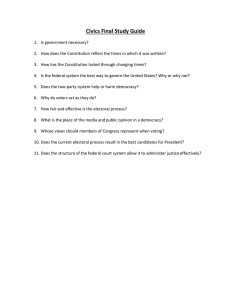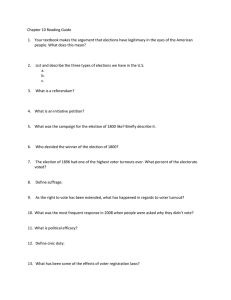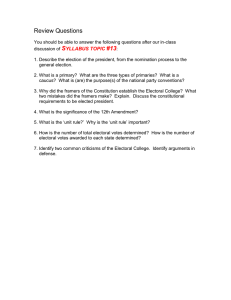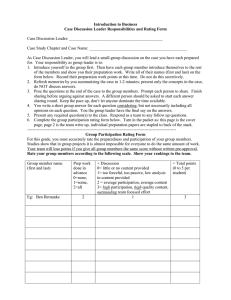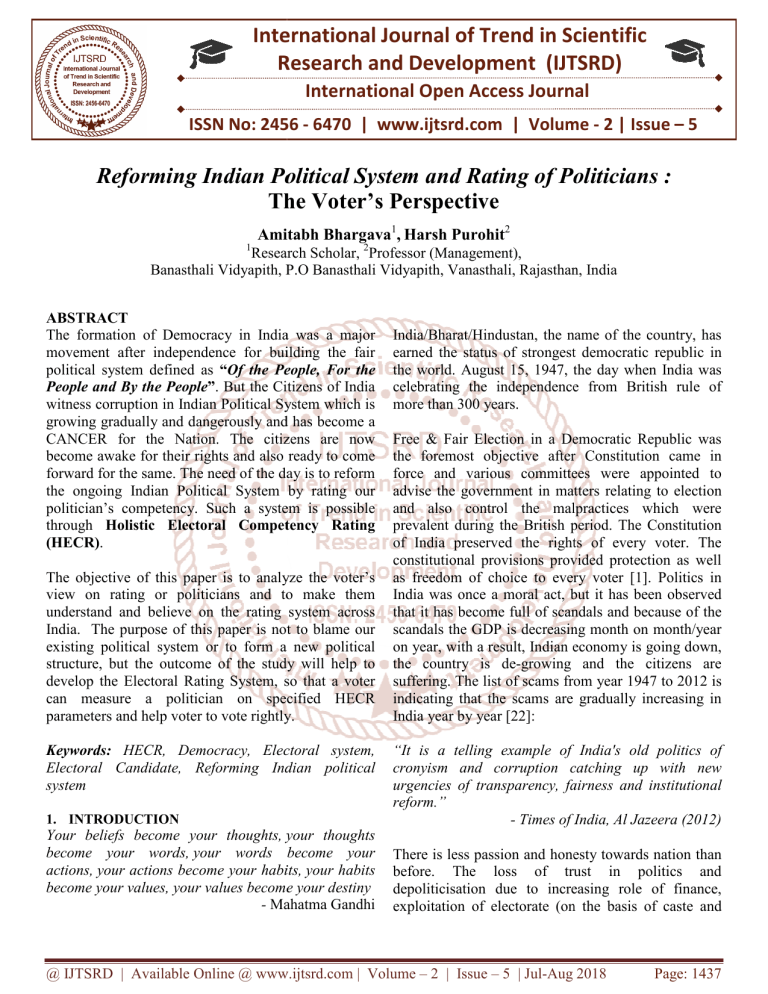
International Journal of Trend in Scientific
Research and Development (IJTSRD)
International Open Access Journal
ISSN No: 2456 - 6470 | www.ijtsrd.com | Volume - 2 | Issue – 5
Reforming Indian Political System and Rating off Politicians :
The
he Voter’s Perspective
Amitabh Bhargava1, Harsh Purohit2
1
Research Scholar
Scholar, 2Professor (Management),
Banasthali Vidyapith, P.O Banasthali Vidyapith, Vanasthali, Rajasthan,
Rajasthan India
ABSTRACT
The formation of Democracy in India was a major
movement after independence for building the fair
political system defined as “Of
Of the People, For the
People and By the People”.. But the Citizens of India
witness corruption in Indian Political System which is
growing gradually and dangerously and has become a
CANCER for the Nation. The citizens are now
become awake for their rights and also ready to come
forward for the same. The need of the day is to reform
the ongoing
ngoing Indian Political System by rating our
politician’s competency. Such a system is possible
through Holistic Electoral Competency Rating
(HECR).
The objective of this paper is to analyze the voter’s
view on rating or politicians and to make them
understand
stand and believe on the rating system across
India. The purpose of this paper is not to blame our
existing political system or to form a new political
structure, but the outcome of the study will help to
develop the Electoral Rating System, so that a vot
voter
can measure a politician on specified HECR
parameters and help voter to vote rightly.
Keywords: HECR, Democracy, Electoral system,
Electoral Candidate, Reforming Indian political
system
India/Bharat/Hindustan, the name of the country, has
earned the status of strongest democratic republic in
the world. August 15, 1947, the day when India was
celebrating the independence from British rule of
more than 300 years.
Free & Fair Election in a Democratic Republic was
the foremost objective after Constitution came in
force and various committees were appointed to
advise the government in matters relating to election
and also control the malpractices which were
prevalent during the British period.
period The Constitution
of India preserved the rights of every voter. The
constitutional provisions provided protection as well
as freedom of choice to every voter [1]. Politics in
India was once a moral act, but it has been observed
that it has become full of scandals and because of the
scandals the GDP is decreasing month on month/year
on year, with a result, Indian economy is going down,
the country is de-growing
growing and the citizens are
suffering. The list of scams from year 1947 to 2012 is
indicating that the scams
cams are gradually increasing in
India year by year [22]:
1. INTRODUCTION
“It is a telling example of India's old politics of
cronyism and corruption catching up with new
urgencies of transparency, fairness and institutional
reform.”
- Times of India, Al Jazeera (2012)
Your beliefs become your thoughts, your thoughts
become your words, your words become your
actions, your actions become your habits, your habits
become your values, your values become your destiny
- Mahatma Gandhi
There is less passion and honesty towards nation than
before. The loss of trust in politics and
depoliticisation due to increasing role of finance,
exploitation of electorate (on the basis of caste and
@ IJTSRD | Available Online @ www.ijtsrd.com | Volume – 2 | Issue – 5 | Jul-Aug
Aug 2018
Page: 1437
International Journal of Trend in Scientific Research and Development (IJTSRD) ISSN: 2456-6470
religion), switching political parties, criminalization
of politics, corruption and other such problems have
weaken our democratic structure. Further, we the
citizens of India, has witnessed that the way the
political parties are doing election campaigning is
itself a cause of worry. The politicians openly indulge
in vote bank politics. They target the vulnerable poor
population which represents the 60% of our
population. As a result of which wrong people are
elected who are just interested in promoting their own
welfare.
We can see the present situation of voters who have
no choice to elect better among the candidates for
their constituency. Certain reforms should be brought
such that the candidate stood for election shouldn't
have at-least a single case filed against him.
“Corruption being snake in the grass” and apart of
these entire curses our golden birds still are waiting
for a roar by responsible and talented youth.
Here is the need is reforming the Indian Political
System. Sukhdev Singh (2012) also raised this issue
in his article on “Electoral reforms in India” [2]. This
article deals with the electoral reforms which can be
introduced in India. The present electoral system in
India has a lot of drawbacks which need to be set right
for free and fair elections in the country.
The apprehensions have no end but are not convincing
enough to deter someone from making a modest start.
Armstrong and Graefe (2010) identified 60 variables
[3] but the purpose was not rating before elections but
rather to prepare an index to explain outcome of US
Presidential elections.
The Holistic Electoral Competency Rating (HECR)
[4] is a rating system that benchmarked the index to
rate the qualities of great political leaders and
identifying entry level competencies. If the electoral
reforms and rating suggested are carried out by the
citizens and government sincerely, then we can feel
proud of our democratic system and project our
system as model to be followed by the other newly
emerged democratic countries of the world.
2. OBJECTIVES
1. To evaluate attitude of Indian Citizens about need
and process of HECR in India
2. To evaluate the possible alternatives and
governance structure of rating agencies that
should rate the politicians.
3. REVIEW OF LITERATURE
Garg Rishab, Sneha Ritwik (2012) talked about the
electoral reforms as an approach to effective
democracy in India [1]. Sanjay Kumar (2002) stated
that the attempt to reform the electoral system is a
welcome move. However, the current proposals on
candidates' disclosures of various kinds do not appear
to be well-constructed and the bill includes
ambiguities which are open to misinterpretation. It is
perhaps more important immediately to strengthen the
system of preparing electoral rolls and allowing
public access to them [2].
Armstrong and Graefe (2010) used the take-the-best
heuristic to develop a model to forecast the popular
two party vote shares in U.S. presidential elections.
The take-the-best heuristic generated accurate
forecasts based on voters’ perceptions on how the
candidates will handle the single most important issue
facing the country [3].
Purohit (2011) proposed the Educationist perspective
on rating the politicians through Holistic Electoral
Competency Rating (HECR). He stated that all
facets of Holistic development of our country are
affected by role played by a value chain involving
spiritual, social & market values. Even though the
role of state (Government) seemed to be lesser in
market driven economy, the need to catalyze and be a
guiding force for various facets of Holistic
development cannot be underestimated. He proposed
the rating for a politician just like applicable for an
IPO or CP or any other Debt instrument or Corporate
Governance
or
Universities. He
suggested
implementing such a system in India where the citizen
can rate a politician [4]. They also highlighted upon
the conditions under which index models are useful as
a reply to Bio-index Commentaries [5] and tested the
index method for Predicting Elections from
Biographical Information about Candidates [6].
Cuzán, A. G. & Bundrick, C. M. (2009) articulated an
idea for predicting presidential elections with equallyweighted regressors in Fair's equation and the fiscal
model [7]. Simonton Dean K. (1993) discussed what
political psychology might have to offer in making it
more likely that the best leaders might become
Presidents of the United States [8]. Petrocik, J. R.
(1996), proposed “Issue ownership theory” of voting
that emphasized the role campaigns in setting the
criteria for voters to choose between candidates [9].
@ IJTSRD | Available Online @ www.ijtsrd.com | Volume – 2 | Issue – 5 | Jul-Aug 2018
Page: 1438
International Journal of Trend in Scientific Research and Development (IJTSRD) ISSN: 2456-6470
Lau, R. R. & Redlawsk, D. P. (1997) proposed a
system for the voter to vote “correctly”. They stated
that the average voter falls far short of the
prescriptions of classic democratic theory in terms of
interest, knowledge, and participation in politics. [10].
Nicholas R. Miller (1980) proposed a new Solution
Set for Tournaments and Majority Voting with special
emphasize on Further Graph-Theoretical Approaches
to the Theory of Voting [11]. Wlezien, C. (2005)
commented on the salience of voters on political
issues. [12].
Matthew Atkinson, Ryan D. Enos Seth & J. Hill
(2009) examined the candidate faces and election
outcomes in their paper [13]. Dawn Brancati (2011)
investigated in his paper, the effectiveness of an
important form of democracy promotion, electoral
monitoring, in terms of its impact on citizens’
perceptions of democracy and their subsequent
participation in politics through a field experiment in
Kosova [14].
T T Ram Mohan (2007) also stressed upon reforming
Indian politics in his column in The Economic Times.
He raised some burning issues like Criminalization of
politics, the absence of state funding of elections, an
increasingly politicized bureaucracy, a moribund legal
system [15].
The papers reviewed above motivate the researcher to
build a rating system in India for reforming our
Political System. New electoral monitors in addition
to existing monitors proposed by Dawn Brancati
(2011) are to be identified. Also key variables
suggested by Armstrong and Graefe (2010) for US
elections are benchmarked for identifying new
variables for entry level competencies of a politician.
New parameters will be added with existing HECR
parameters in order to perform holistic rating of an
electoral candidate.
4. METHODOLOGY
Feasibility Study is an important phase of any system.
Here the Survey method is used to carry out the study
to get the details from the respondents of different
focus groups. The research instruments intended for
the study are questionnaires, web based tools,
interviews, discussion groups, social networking and
case studies. Questionnaire and Schedule is designed
after careful analysis. Researcher administered
questionnaires are planned for this study as this
method facilitates the collection of data with proper
clarification of questions, if required. Further, it
ensures a higher response rate. Various methodologies
like graphs, matrixes, comparison tables for analyses
of responses of various questions are used after
questionnaire survey. The research will be under
descriptive study which will include large population
studies in which data on lots of different variables will
be collected. Questionnaire has undergone pilot study
and cronbach alpha testing.
5. MOTIVATION OF RESEARCH
This paper is based upon the Proposed HECR model
by Purohit, 2011. This model covers the parameter
like Awareness Parameters, Track Record, personal
& family conditions, Opinion of voters, Vision,
Mission & Execution and affirmation of electoral
candidate
A candidate may be asked to submit about all above
in writing and than face an interview. The final report
should bear his signature assuring all above is true &
valid. The above can be called as HECR (Holistic
Electoral Competency Rating).
The HECR
parameters and weightage may vary based on:
1. New Candidate
2. Old Candidate (Winner/Looser earlier)
3. Candidate seeking a ministerial portfolio (needs
assessment about awareness of ministry as well)
For new candidates the weight age can be 30% each
for A and B while 20% for C and 10% each for D and
E. While for old candidates the weight age can be
different. The score obtained by candidates can be
indexed and compared, and a rating can be assigned
based on index value.
6. PROPOSED ENHANCED HECR SYSTEM
FOR RATING OF POLITICIANS
The focus of this study is to understand the
requirement of rating of politicians and changes in
existing electoral system with voter’s perspective. The
data has been collected through questionnaire by
using different parameters. The questionnaire
contained total 90 questions in 9 different categories
like personal profile, voter’s insight, Voter’s view on
Democracy, Factors influencing voters’, Attributes of
a leader-Voter’s perspective, Voter’s opinion poll and
Rating of Politicians-Before and After Election.
The data was collected from 1232 citizens from 27
different states including 2 NRIs in USA and
Republic of Mauritius.
@ IJTSRD | Available Online @ www.ijtsrd.com | Volume – 2 | Issue – 5 | Jul-Aug 2018
Page: 1439
International Journal of Trend in Scientific Research and Development (IJTSRD) ISSN: 2456-6470
7. SAMPLING
Convenience sampling and random sampling shall be
used to get information from respondents. The sample
comprised of 1232 responders (14 type of professions,
4 age-groups and 71% males and 29% females as
criteria for classification) located throughout India
(predominantly limited to netizens i.e. internet users
outside Rajasthan/NCR). Study covered citizens from
four main regions of India 37% from Jaipur, 15% rest
cities of Rajasthan, 17% from NCR Region and 32%
PAN India other than Rajasthan & NCR. The
responses were collected for preliminary feel of
Indians about the research theme.
Figure 1: Percentage sample collection from different category of citizens
8. Tools of Data Collection
The research is
under descriptive study
which includes large population studies in which data
on lots of different variables are collected.
For this study, the Primary and Secondary sources of
data collection are as under.
Primary Sources: Citizens of India who are eligible
to vote.
Secondary Sources: Constitution of India, Govt. of
India Websites, Annual reports, Books, Research
Papers published in journals, Online Blogs, Articles,
and Social Forums etc.
The questionnaire was developed on the basis of
Proposed HECR by Purohit, 2011 published in Times
of India. This was the Research Model for this study.
The parameters suggested were called HECR
(Holistic Electoral Competency Rating):
Awareness Parameters
Track Record, personal & family conditions
Vision, Mission & Execution
Opinion
Affirmation
To highlight this study, we have prepared first draft of
questionnaire and included around 70 questions. The
pilot study was conducted for 70 respondents. Based
upon their feedback and expert opinion and cronbach
alpha testing we have included around 27 questions
comprises of 89 sub questions.
9. Tools of Data Analysis
The purpose of the data analysis and interpretation
phase is to transform the data collected into credible
evidence about the development of the intervention
@ IJTSRD | Available Online @ www.ijtsrd.com | Volume – 2 | Issue – 5 | Jul-Aug 2018
Page: 1440
International Journal of Trend in Scientific Research and Development (IJTSRD) ISSN: 2456-6470
and its performance. This helps in aligning the desired
“report” with the results of analysis and interpretation.
In this research, both qualitative and quantitative
analysis is involved. Grounded theory of qualitative
research is used. Statistical analysis is conducted
through factor analysis, Chit-Square Test, Analysis of
Variance (ANOVA), Mean scores etc. using advanced
Excel add-in tool for quick and accurate calculations.
Analysis of variance (ANOVA) tests the hypothesis
that the means of two or more populations are equal.
ANOVA assess the importance of one or more factors
by comparing the response variable means at the
different factor levels.
10. Significance of study
In present scenario, the role of a citizen in selection of
an electoral candidate is limited to the fundamental
right of voting. The electoral candidate they’ve
chosen decides the directions for the democratic
environment. Why always the Indian political system
should be blamed, though the citizens are also equally
responsible. The need is, to aware the citizen for not
only to use their right of vote but also to vote rightly.
The research work is an attempt to develop the fair
system for the rating of a politician with a special
emphasize on self-realization and self-assessment
among the citizens as well as politicians.
11. Scope of Study
The scope of this study is not limited to specific
region as the study belongs to each citizen of India.
For this study, we have categorized four regions
Jaipur, Rajasthan, NCR and PAN India. Similarly the
scope of study is limited to the citizens who is eligible
to vote, aged more than 18 years and whose name is
in voter’s list. The study is carried out on each citizen
ranging from academicians, corporate professions to
house wives, un-educated citizens in rural or urban
areas and also farmers.
with the statement "The Democracy in India reflect
‘Government of the people, for the people, and by the
people'?"; we the Indians are proud to be the largest
democratic country in the world; Ranking of different
functionaries who are working well for the betterment
of the nation; and Ranking of different challenges to
the Democracy of our nation.
Fig. 2: Respondents agreement to the statement on
Likert Scale
Fig. 3: Respondents agreement to the statement on
Likert Scale
Fig. 4: Raking of functionaries working for the
betterment of India
12. Limitations of study
The limitation of this study is majorly the
acceptability from the citizens of India that they
should understand the value of their vote. They should
also understand how the rating of politician would
help them in selecting the right leader in their
constituency. Following major limitations are
identified in this study:
13. Voter’s View on Democracy
The purpose of this section is to analyze the
respondents view on Democracy like their agreement
Fig. 4.5: Ranking on Challenges to Democracy of our
nation
@ IJTSRD | Available Online @ www.ijtsrd.com | Volume – 2 | Issue – 5 | Jul-Aug 2018
Page: 1441
International Journal of Trend in Scientific Research and Development (IJTSRD) ISSN: 2456-6470
BIBLIOGRAPHY
1. Rishab Garg & Ritwik Sneha (2012), Electoral
Reforms: An Approach To Effective Democracy,
Legal Services India, ISBN No: 978-93-82417-019
2. Sanjay Kumar (2002), Reforming Indian Electoral
Process, Economic and Political Weekly, Vol. 37,
No. 34 (Aug. 24-30, 2002), pp. 3489-3491
Figure 6: Response on requirement to rate the
politicians-Before and After election
3. Graefe, Andreas, Armstrong, Scott J. (2010),
Predicting elections from the most important
issue: A test of the take-the-best heuristic, Journal
of
Behavioral
Decision
Making;
DOI:
10.1002/bdm.710
4. Harsh Purohit (2011), Educationist perspective on
rating the politicians through Holistic Electoral
Competency Rating (HECR), Online journal of
www.indianmba.com
Fig. 7: Response on the organization authorized to do
Rating of Politicians
14. Conclusion
Based upon the 1232 responses on requirement to rate
the politicians before and after elections, majority of
respondents i.e. 99% strongly agree and showed their
positive response towards the need of rating process.
Out of 1232 respondents, 71% satisfied with the
functioning of Election commission of India for such
rating. Total 18% respondents feel government
agencies as another alternative. On the other hand,
only 9% rated for private agencies and 2% for News
Channels. Election commission should rate the
politicians on different parameters of rating before
and after elections. This rating system proposed in
this research can be used to rate the politicians and
publicize it on their portals.
As Majority of respondents agree upon the need of
rating of politicians and feel that the Election
Commission should publish a constitute-wise
comparative analysis of contestants covering all major
attributes. This rating system would help Election
commission to publish such data before elections. As
majority of respondents who are in favor of rating of
politicians feel that the
5. Andreas Graefe, J. Scott Armstrong (2011),
Conditions under which index models are useful:
Reply to Bio-index Commentaries, Journal of
Business Research, Volume 64, Issue 7, Pages
699–706
6. Armstrong, J.S. and Graefe, A. (2011), Predicting
Elections from Biographical Information about
Candidates: A Test of the Index Method, Journal
of Business Research, Vol. 64(7). p. 699-706.
7. Cuzán, A. G. & Bundrick, C. M. (2009),
Predicting presidential elections with equallyweighted regressors in Fair's equation and the
fiscal model, Political Analysis 17, 333-340. DOI:
10.1093/pan/mpp008
8. Simonton Dean K. (1993), Putting the Best
Leaders in the White House: Personality, Policy,
and Performance; Political Psychology, Vol. 14,
No. 3, pp. 537-548
9. Petrocik, J. R. (1996), Issue ownership in
presidential elections, with a 1980 case study,
American Journal of Political Science, Vol. 40,
No. 3, pp. 825-850
10. Lau, R. R. & Redlawsk, D. P. (1997). Voting
correctly, American Political Science Review,
Vol. 91, No. 3, 585-598
11. Nicholas R. Miller (1980), A New Solution Set for
Tournaments and Majority Voting: Further GraphTheoretical Approaches to the Theory of Voting,
American Journal of Political Science, Vol. 24,
No. 1, pp. 68-96
@ IJTSRD | Available Online @ www.ijtsrd.com | Volume – 2 | Issue – 5 | Jul-Aug 2018
Page: 1442
International Journal of Trend in Scientific Research and Development (IJTSRD) ISSN: 2456-6470
12. Wlezien, C. (2005), On the salience of political
issues: The problem with ‘most important
problem’, Electoral Studies, 24, 555-579.
DOI:10.1016/j.electstud.2005.01.009
19. Redlawsk, D. P. (2004), What voters do:
Information search during election campaigns,
Political Psychology, Vol. 25, No. 4, 595-610.
DOI: 10.1111/j.1467-9221.2004.00389.x
13. Matthew D. Atkinson, Ryan D. Enos and Seth J.
Hill (2009), Candidate Faces and Election
Outcomes: Is the Face–Vote Correlation Caused
by Candidate Selection?, Quarterly Journal of
Political Science, Vol. 4, pp. 229–249
Webliography
20. http://currentgk.com/india/polity/constitution_indi
an_polity.html
14. Dawn Brancati (2011), Democracy Promotion:
Citizens’ Perceptions of Electoral Monitors,
15. T T Ram Mohan (2007), Reforming Indian
politics, The Economics Times, Bennett, Coleman
& Co. Ltd
16. Graefe, A. and Armstrong, J. S. (2012),
Forecasting Elections from Voters' Perceptions of
Candidates' Ability to Handle Issues. Journal of
Behavioral
Decision
Making.
doi: 10.1002/bdm.1764
17. Divyanshu (2002), A blueprint for political reform
in India, CRISIL Young Thought Leader 2002
18. Jennifer Corriero (2004), Role of Youth Survey,
TakingITGlobal
21. http://india.gov.in/govt/constitutions_india.php
22. http://forum.topnews.in/threads/4861-List-OfScams-In-India
Books/e-Books
23. HE A. P. J. Abdul Kalam, Book on “eGovernance Overview and Project Assessment”,
Chapter 1: A Vision of Citizen-centric eGovernance for India
24. Perri 6, Holistic government, Demos, London,
ISBN 1 898309 04 3
25. Sk Khanna, Reforming Indian Political System,
Commonwealth
Publishers,
1999,
ISBN
9788171695355
26. Key Competencies for Improving Local
Governance, Volume 3: Concepts and Strategies,
UN-HABITAT, ISBN 92-1-131731-2
@ IJTSRD | Available Online @ www.ijtsrd.com | Volume – 2 | Issue – 5 | Jul-Aug 2018
Page: 1443

